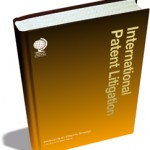As the importance of technology-based products and processes continues to increase, so too does the significance of patents. Unsurprisingly, therefore, patent-related disputes are becoming more common and their consequences more significant than ever. Likewise, globalization means that patent disputes must increasingly be managed on an international rather than local level.
However, the lack of a harmonized patent dispute resolution system across the major jurisdictions means that this is not a simple exercise. Actions taken in one jurisdiction can have unforeseen consequences in another; the time taken in the various jurisdictions to reach a conclusion can vary considerably; and the measures and remedies available differ from country to country.
“International Patent Litigation: Developing an Effective Strategy,” Edited by David Wilson (Globe Law & Business Publishing Ltd. 2009), is a collection of articles covering patent litigation strategy from over 15 countries has been put together. Before enforcing any patent rights, you need to develop an effective strategy for using litigation as a means to an end. Editor David Wilson provides an overview of the issues in strategy development stating the case thusly:
“[D]ifferent countries approach patent litigation differently, both from a procedural point of view and substantively. As a result, not only are the procedures by which patent disputes are resolved different, but different remedies can be available and the length of time to obtain resolution can vary widely.”
Wilson sets out that the patentee must determine the landscape. That is, what patents, if any, have been infringed? What are the relative strengths and weaknesses of the rights? Once the landscape is set out, the patentee must consider when and where to litigate. Many of the factors to consider include the availability of pre-action discovery and disclosure, the availability of interim relief such as preliminary injunctions, the timetable for proceedings, the discovery process, each jurisdiction’s substantive and procedural patent laws and the cost of patent litigation in the jurisdiction(s) in question, of course.
The remainder of the book covers the aspects involved on a country-by-country basis — mainly Europe, Japan and the U.S. — with each jurisdiction covered by an expert in that country’s litigation practice. This book is a practical guide for those involved in the management of international patent litigation, from in-house professionals (patent managers, patent attorneys and general counsel) to those in private practice.
While not for the casual reader, “International Patent Litigation: Developing an Effective Strategy” will be invaluable for developing a strategy for protecting against infringements, preparing proper litigation strategy, estimating costs of litigation, and preparing to engage local counsel. This is a guide for understanding not just the lawyers in certain jurisdictions but the very court system and how patent cases are heard. By looking at the types of cases heard in the courts and the timetables involved, a patentee can make an informed decision on moving ahead with an action.
International Patent Litigation: Developing an Effective Strategy is available from Amazon and from Globe Law & Business Publishing Ltd. (gbplawbooks.com).


Is this one of those books with chapters written by the different national offices of the editor’s own law firm, with as many pages devoted to Greece as to Germany, England or the USA. No sign of The Netherlands? I had thought that people litigated in Europe in Holland, as often as in England and Germany, no?
MAX,
The book does offer two chapters by the editor’s own law firm, Herbert Smith LLP: Paul England and Sebastian Moore writing on UK law and Alexandra Neri covering France.
However, the bulk of the chapters are by practitioners in firms that (at least on the face) are not affiliated with the editor’s firm.
The book covers Austria, Belgium, Denmark, Finland, France, Germany, Greece, Ireland, Italy, Japan, Poland, Portugal, Spain, UK and US, set out over about 260 pages once you take out the preface and the editor’s chapter on developing and managing an IP strategy. As you note above, the book does not include a section on the Netherlands.
I suppose that a patentee brings litigation where they must, not just were it’s popular, but your point is well taken.
Stephen
Thanks Stephen. You know, I’m wondering if there is no NL “chapter” because all the patent litigators in that busy jurisdiction were just too busy to write anything for this book.